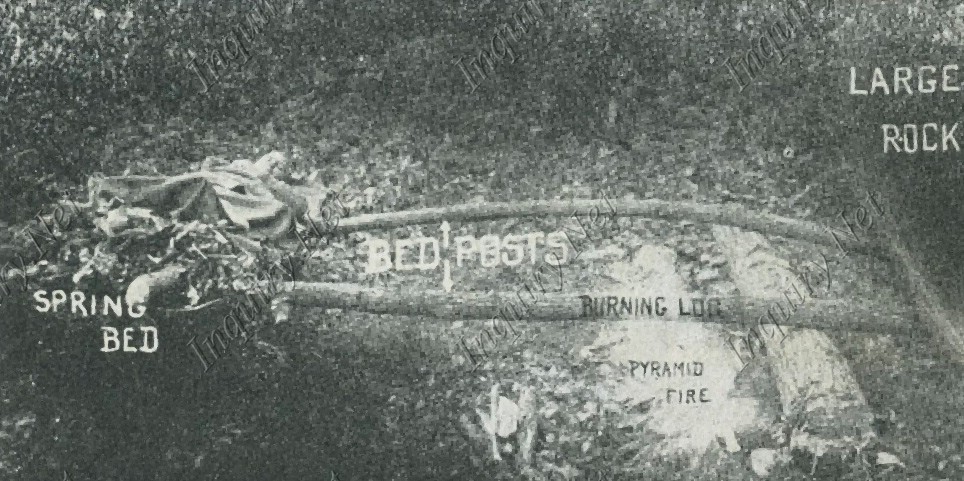PART V
Camp Fires
Log Cabin Council Fire (19). This fire is used for illuminating a camp fire circle or council ring. It is intended for summer use and is designed to furnish light rather than heat. The pyramid fire built in the center of the log construction will burn brightly regardless of changes in direction of the wind. The object of the side-logs is to hold the firewood erect so that it will produce a tall conical flame.
The tendency of inexperienced campers is to build as large a camp fire as their wood supply will permit. The experienced director knows that he can secure a more desirable atmosphere by building a small bright fire; so he saves the large bonfire for grand celebrations.
Selection of Wood. Select very slow-burning woods for the green side-logs. (See Very Slow-

Log Cabin Council Fire
Burning Firewoods, No. 21.) For the firewood used to produce the blaze select dry softwoods, old lumber, box wood, or. the better burning hardwoods, split thin. Remember, split wood always burns better than round sticks. Why?
Star or Lazy Man Fire (20). Since this fire is fed with long logs, it is used for many purposes by campers who are without axes or are too lazy to use them. It can be recommended to overnight hikers who happen to be without an ax. When one of the sleepers is awakened, he can replenish the fire without getting out of bed by simply rolling the log beside which he is lying into the fire. The rollers upon which the radiating logs are placed also serve the purpose of damper-sticks, for they raise the logs from the ground permitting them to burn more freely. Since the ends of large logs will smolder all night, a lazy man fire may be used to make a smudge by covering it with dry grass dampened or weeds soaked with water.

Star or Lazy Man Fire
Non-Sparking Night Firewood. To insure a fire that will burn throughout the night without shooting embers on your blankets, you must select the fuel carefully. The following woods are good : white oak, white ash, hard maple, birch, beech, dogwood, ironwood, locust. Avoid the very slow-burning woods listed in Nessmuk Fire No. 21. Discard dry seasoned woods that crackle and scatter burning embers. such as balsam, box elder, cedar, chestnut, hickory, poplar, tulip, sassafras, spruce, and most of the evergreens.
1. Why would this fire be good for cooking a stew?
2. What kind of a fire would you build in the center of the logs to get heavy logs burning?
3. Which would be safer for outside bedding, a poncho or blanket?
Wind-Break Reflector or Nessmuk Fire (21). This fire is designed for cold weather camping, to throw heat into a tent or lean-to. The backlogs, which should be very slow-burning green logs, break the wind and reflect heat into the shelter. The best slow-burning woods (See Fire No. 12) should be used for firewood.

Nessmuk Lay for Cold Weather
When this fireplace is to be used for several nights, the stone Adirondack Wind-Break (illustrated in the insert) is preferable to a log structure.
Very Slow-Burning Firewoods. Aspen, basswood, balsam, box elder, buckeye, butternut, chestnut, swamp elm, hemlock, gum, larch, persimmon, poplar, pine (black or white), red maple, red oak, sourwood, sycamore, tulip and willow burn very slowly, especially when green.
1. What would you use to chink the backlogs? Why chink?
2. The wind-break might be made to stand erect, or to slope forward or backward. Which way is best? Why?
3. If a large boulder were available for the wind-break, would you select it in preference to the backlogs?
Alarm Clock Fire (22). This ingenious contrivance was used by lumbermen and woodsmen before alarm clocks were carried in camp outfits. When it was necessary for one member of a party to arise before daylight to prepare breakfast, so that the others could move at the break of day, the alarm clock fire awakened the cook. It was also used in the north, in

Alarm Clock Fire
extremely cold weather, to arouse sleepers and prevent them from freezing.
The spring bed, illustrated on the ends of the long bed posts, is made o: boughs. The other ends of the logs are wedged under a large boulder. A fire, the size of which must be determined by experiment, is kindled under the post supporting the sleeper's feet. This alarm clock is guaranteed to be more effective than the bedroom type, for since it lets the sleeper down, it never fails to get him up.
1. Can you suggest any other way to make this kind of a fire?
2. Can you think of a practical situation in which you might use this fire?
3. Would any of your club members be interested in experimenting, with it on an overnight hike?